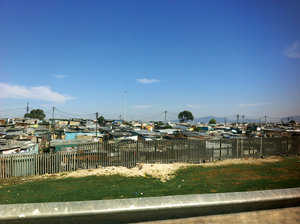
Photo: Cities-Today
Cape Town must use design award to close the urban divide
17 July 2014
by Richard Forster
Cape Town is celebrating its new found honour as the World Design Capital 2014 but as Roman Rollnick observes from his recent visit, the city has a long way to go in bridging the urban divide between its residents
Cape Town beat off the competition from Bilbao and Dublin to be named the World Design Capital for 2014 and its city’s business, community and political leadership are to be commended for their selection of projects which will serve Cape Town well into the future.
The four themes the city has selected as part of the Design Capital showcase an upbeat outlook. The choice of the first theme, ‘African Innovation. Global Conversation – African ideas that speak to the world,’ recognises that this proud city is the first design city to represent Africa.
The second theme: ‘Today For Tomorrow – Sustainable solutions for people and the planet’ is particularly important in a rapidly urbanising world where in little over a generation from now, two-thirds of the global population will be living in towns and cities.
‘Beautiful Spaces. Beautiful Things – Inspiring architecture, interiors, food, fashion, jewellery, craft, art and creativity’ – is important as the third theme because people need to feel that they belong and that the city is inclusive.
However, perhaps the most important and the most challenging is the final theme: ‘Bridging the Divide – Design that reconnects our city and reconciles our communities’.
Cape Town is trying hard to bridge the divide, as shown by the fact that according to Mayor Patricia de Lille, each of the city’s 111 wards will this year present a new community project.
But a closer look at the World Design City 2014 projects raises the question of how far the city is really going in its drive to bridge the divide, in particular, whether the city is committed to adequate housing for all of its citizens, including the much maligned army of immigrants from poorer African countries who service so many of the locals.
In years of meetings with the city and the South African government, UN-Habitat, the Nairobi-based city agency of the United Nations, has repeatedly called for urgent action on bridging the urban divide, and providing adequate housing and basic services for the poorest of the poor.
Officially, the population of Cape Town is given as 3.6 million but how many million live in the slums which now stretch as far as the eye can see from the edges of town? The South African Cities Network has estimated that these slum inhabitants add up to 20 percent to the city’s population.
It must be embarrassing for Capetonians when a global agency like the Cities Alliance, affiliated with the World Bank, the European Union and UN-Habitat, recently depicted Cape Town in a photograph on its website as one big slum city. Forget Table Mountain and the famous winelands–the first sight greeting every visitor arriving at Cape Town airport these days is the sea of shacks shown in that photograph.
Improving liveability
“You can plan and design until you are blue in the face, but if governmental intervention and development control is reactive rather than proactive, slums emerge before the authorities have the intervention powers in place,” says Joseph Maseland, an architect and urbanist who edits UN-Habitat’s authoritative Regional State of the Cities reports.
Take any Brazilian visitor to the suburb of Hout Bay near Cape Town, which is so reminiscent of Ipanema Beach in Cape Town’s sister city Rio de Janeiro for its picture postcard beauty of green mountains rising out of the blue Atlantic, and what do they notice? Cape Town’s first Brazilian-style favelas–slums creeping up the mountainside, just like they do above Ipanema.

Still more disturbing is the fact that South African cities – Cape Town included – top the list of the world’s most unequal cities according to the latest UN-Habitat research on income distribution.
This gulf between rich and poor is measured by the Gini Index, the most widely used gauge of inequality. It measures either the distribution of household income or consumption spending in a country. A zero value implies perfect equality with resources distributed proportionally amongst all households, while 1.0 signifies perfect inequality, where one household has all of the nation’s income and no one else has any.
The global list of cities surveyed in 109 countries is topped by South African cities. East London is followed by Johannesburg, East Rand, Bloemfontein, Pietermaritzburg, Pretoria, and then Cape Town, itself with a Gini Coefficient of 0.67, with the average at 0.73. That compares to the average of 0.5 in Latin America where Brazil leads, followed by Colombia, Argentina, Chile, Ecuador, Guatemala and Mexico.
Promoting and protecting women
UN-Habitat has also been at pains in meetings with South African officials to make it clear that no city can ever breach the divide or indeed sell itself as a city of advancement if its women do not feel safe, or if they lack the protection of adequate shelter and adequate sanitation.
According to the National Prosecuting Authority, an average of between 26-30 rape cases go to trial each week in the Cape Town area fuelling the city’s reputation as the rape capital of the world. Indeed, the Medical Research Council’s Gender and Health Research Unit says six rape cases are reported to the police every hour. And most of these occur in Cape Town’s poorer shack communities.
Why should women have to risk their lives and dignity walking to outdoor sanitation facilities? Why of 450 projects for World Design City 2014 does only one appear to be specifically gender oriented?
“The urban poor are more exposed to violence than the rich, and since women make up the majority of the urban poor they are more exposed to crime at every level. And this is particularly the case in slums,” says Dr Anna Kajumulo Tibaijuka. One of Africa’s greatest stateswomen, Tibaijuka is the former Under-Secretary- General of the United Nations in charge of UN-Habitat and today, serves as Minister of Lands, Housing and Human Settlements Development of Tanzania.

During her decade at the United Nations, she never lost a chance to personally make this clear to South African leaders at every level.
“Of the 1.2 billion people in the world living in poverty, 70 percent are women,” adds Tibaijuka. “The urban poor are less likely to recover from the impacts of violence when there are little or no support systems available for them, such as access to insurance, counselling, health care, education or financial resources. The potential for making cities responsive to the needs of women and the aspirations of youth will largely depend on the way cities are built, managed and governed. Planning for promoting equitable, women-friendly and balanced city development is the starting point.”
I have personally witnessed Dr Tibaijuka raise her voice, and sometimes bang her fist on the table at meetings with city leaders and urge them: make your city woman-friendly starting with the young women and youth in the slums. Provide clean water, and proper sanitation: “Water is life, sanitation is dignity!”
These alarming realities stand as warnings, in Cape Town and beyond, urging us towards renewed global commitment to Sustainable Development Goals but achieving sustainable urban development as Mayor De Lille rightly urges, is likely to prove impossible if the urban divide is allowed to persist and grow.
Such a divide produces social instability generating high social and economic costs not only for the urban poor but for society at large. And in their quest for sanitation and dignity, people living in the Cape Town slums have taken to throwing human waste at visiting dignitaries in a new form of protest that has gained much momentum over the past year.
Opportunities presented by the World Design City 2014 can help Cape Town make a new start, and show itself as a place of inclusion and participation. But does Cape Town really have the courage to take a hard, honest look at the reality and show itself deserving of the great honour bestowed upon it as World Design City 2014?
Cape Town was designated World Design Capital 2014 at the International Design Alliance (IDA) Congress in October 2011 in Taipei. This prestigious designation is bestowed biennially by the International Council of Societies of Industrial Design (ICSID). World Design Capitals recognise the value of design thinking, and are dedicated to using design as tool for social, cultural and economic development. Previous winners have been Helsinki, Seoul and Turin.






